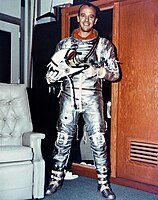Mercury Redstone 3
| Mission emblem | |||
|---|---|---|---|

|
|||
| Mission dates | |||
| Mission: | Mercury Redstone 3 (MR-3) | ||
| COSPAR-ID : | MERCR3 | ||
| Spacecraft: | Freedom 7, serial number 7 |
||
| Launcher: | Redstone Mercury , serial number MR-7 | ||
| Crew: | 1 | ||
| Begin: | May 5, 1961, 14:34:13 UTC | ||
| Starting place: | LC-5 , Cape Canaveral | ||
| Landing: | May 5, 1961, 14:49:35 UTC | ||
| Landing place: |
Atlantic 27 ° 14 ′ N , 75 ° 53 ′ W |
||
| Flight duration: | 15 min 22 sec | ||
| Earth orbits: | suborbital flight | ||
| Recovery ship: | USS Lake Champlain | ||
| Apogee : | 187.42 km | ||
| Covered track: | 487.26 km | ||
| Maximum speed: | 8277 km / h | ||
| Maximum acceleration: | 11 g | ||
| Team photo | |||
 Alan Shepard |
|||
| ◄ Before / After ► | |||
|
|||
The Mercury-Redstone 3 (MR-3) mission on May 5, 1961 is considered the second manned flight in the history of space travel after Juri Gagarin's flight (April 12, 1961) . Alan B. Shepard was the first American outside the earth's atmosphere. The Mercury spacecraft Freedom 7 made only one ballistic flight . Reaching earth orbit was not possible with the Redstone rocket .
The countdown was interrupted 15 minutes before the scheduled start time . There were many clouds in the sky over Cape Canaveral , so that photographic monitoring of the flight was no longer possible. After 52 minutes the sky cleared and the countdown could continue.
According to Alan Shepard, the flight was very calm after take-off. After 45 seconds vibrations set in , which were due to the achievement of the speed of sound ( Mach 1) and the associated breach of the sound barrier . The flight stabilized again after 88 seconds. The Redstone rocket was separated from the spaceship after just under two and a half minutes.
After a total flight time of 15 minutes and 22 seconds, Freedom 7 splashed down in the Atlantic . Helicopters brought Shepard and the Freedom 7 aboard the aircraft carrier USS Lake Champlain after eleven minutes . There he was immediately medically examined. Shepard was in excellent condition and found the flight to be physically unproblematic.
US President John F. Kennedy , who had followed the flight like many other Americans on television, called Shepard while on board and congratulated him on his great success.
Alan Shepard later also took part in the Apollo program and landed on the moon as a mission commander with Apollo 14 .
President Kennedy (center), his wife Jacqueline (right), Vice President Johnson (left) and some military personnel watch the flight on television
Shepard aboard the USS Lake Champlain
Web links
- NASA: Mission Overview (English)
- NASA History Series: Shepard's Ride in "This New Ocean: A History of Project Mercury"




